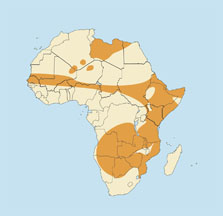 |
Acinonyx jubatus jubatus
DESCRIPTION Length, including tail, 5-1/2 to 7-1/2 feet (165-215 cm). Shoulder height 28-33 inches (70-85 cm). Weight 90-130 lbs (40-60 kg). The female normally has six pairs of teats.
A large, slender cat, hollow-backed, with long, thin legs and a small rounded head. The pale yellowish coat is covered with small black spots and there are distinctive black facial stripes (tear stripes) from eyes to mouth. The hair on the neck and shoulders of males is thicker and forms a slight mane. The tail is long with black bands toward the end, and has a bushy white tip. There are five toes (including dewclaws) on the front feet, four on hind feet, all with blunt, slightly curved claws that only partially retract. Females are smaller, more lightly built and without the slight mane, but are otherwise similar to males.
BEHAVIOR Found alone or in small groups, usually consisting of a female with cubs or several related adult males. Groups avoid each other and mark their areas, but do not seem to defend them. Females give birth at 17-20-month intervals, with the usual number of cubs 3-5 (range is 1-8). Cubs are weaned at 3-6 months of age, leave the mother at 15-17 months, and are sexually mature at 21-22 months. Longevity in the wild 12-14 years, in captivity averages 10-1/2 years, but sometimes as much as 21 years.
Diurnal and carnivorous. Hunts by sight, preying on small or medium-sized antelopes and birds. Unlike most cats, it does not ambush its prey or stalk to within springing distance, but will begin its charge from 75-100 yards (70-90 m) away, or even farther. An overtaken animal is knocked down, then seized by the throat and strangled. Most hunts are said to be unsuccessful, especially when the charge is begun from a longer distance. Does not eat carrion. Requires little or no water and can subsist on moisture from prey animals, or sometimes desert melons.
Its eyesight is exceptional, and its hearing and sense of smell are good. The cheetah is the world's fastest land mammal for a short distance, reportedly able to sprint 50-70 mph (80-112 km/h). Not a good tree-climber, though it does climb them.
HABITAT Semi-desert, grassland and savanna. Rarely in forest.
DISTRIBUTION Small, scattered populations exist throughout Africa, except in the central Sahara Desert and the tropical forest zone.
Outside of Africa, cheetahs are still found in northern parts of the Arabian Peninsula, Iraq, Iran, Russian Turkestan, Afghanistan, Baluchistan (Pakistan), and northern and central India.
REMARKS Not considered a major game animal. It is timid and unaggressive toward man and has been tamed and used to run down game for more than 4,000 years. Protected in most countries; however it may lawfully be hunted in Namibia, South Africa and Zimbabwe under certain conditions, as it is considered harmful to domestic stock.
TAXONOMIC NOTES Smithers lists five subspecies in Africa: hecki (northwestern Africa), jubatus (southern Africa), raineyi (East Africa), soemmerringi (Niger and Nigeria eastward to Ethiopia) and venaticus (formerly Morocco to Egypt, but now probably extinct in Africa).
The king cheetah from Zimbabwe, eastern Botswana and northern Transvaal has been variously described as a full species (Acinonyx rex), as a subspecies (A. jubatus rex), and as an abnormally marked variant-with the latter view the one that is generally accepted. Its distinguishing marks are broad black stripes down the back, and black blotches on the sides and legs. Cubs that have king cheetah markings can occur in otherwise normal litters. As of 1986, 22 king cheetah skins have been preserved and 16 live specimens confirmed, including four cubs born in captivity.
All African forms of cheetah are combined here, with jubatus Schreber, 1776 having priority.
STATUS Still widely but thinly distributed in Africa; however, it has become very rare in the northern part of the continent. In 1975, Myers estimated roughly 15,000 cheetahs remaining in Africa. Its numbers have declined from a number of causes: the spread of people and livestock, excessive hunting of both the cheetah and its prey, the demand for furs, and the capture of live cheetahs for zoos. The cheetah is much less tolerant of the presence of people than is the leopard.
The IUCN classifies the cheetah generally as vulnerable and the subspecies venaticus (Asia, and possibly still in northern Africa) as endangered. All cheetahs are listed as endangered by the USF&WS and are on Appendix I of CITES.
Effective January 1993, CITES approved export quotas for cheetahs from Namibia, Zimbabwe and South Africa. However, the USF&WS has refused to issue any import permits, even though, as a signatory to CITES, the United States is supposed to honor CITES decisions. Because of the unfairness of this, the Record Book has waived its usual rule and is accepting entries of African cheetahs taken by U.S. residents from January 1993 onward under the CITES quotas established for Namibia, Zimbabwe and South Africa.
|





